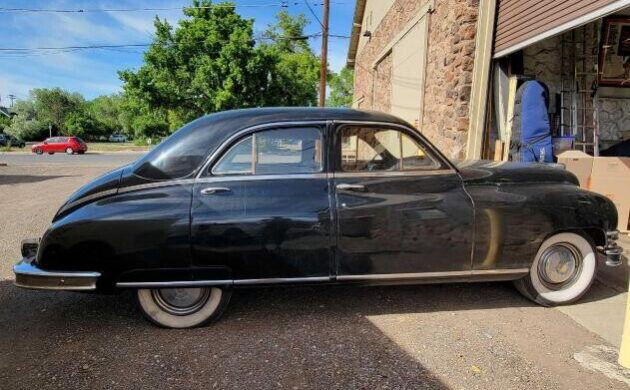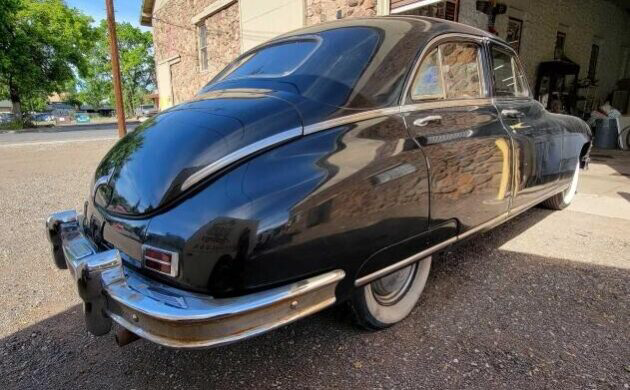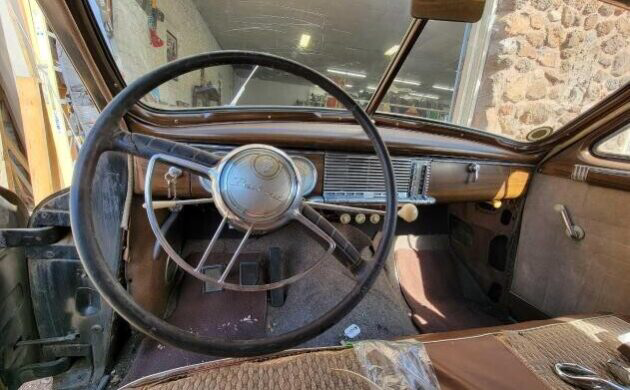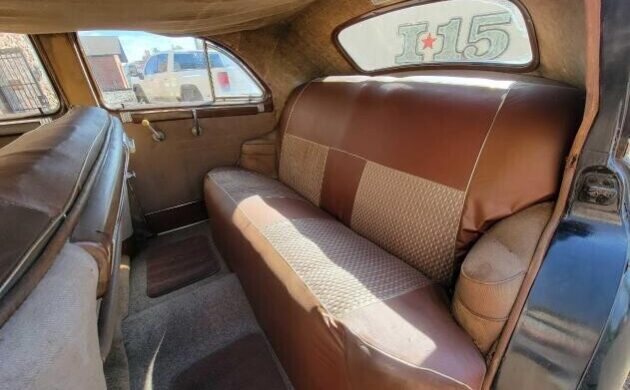The Packard Motor Car Company’s slogan was “Ask the man who owns one.” While the last person to purchase a new Packard off the showroom floor has probably already left the building like Elvis, there is still a chance for you to experience ownership of one of these incredible luxury cars. Take a look at this 1949 Packard Super Eight sedan here on Barn Finds Classifieds. While this black beauty has a few mechanical and cosmetic needs, the current bid of $2,900 leaves a lot of extra cash in your pocket to get this luxury cruiser back to floating down the road.
The post-World War II landscape was hard to navigate for independent automakers. Packard came out of the conflict with a $33,000,000 war chest from the production of such legendary products as the Merlin and Liberty engines. They also had the dies to produce their standard cars, but the ones for the upper-range models were not useable. This was OK when the country was hungry for any type of new car, but that grace period only lasted a few years. The postwar world was no longer one where automakers could rely on producing the same chassis with minimal facelifts every year or so. Customers wanted lower, sleeker, and faster models.
This was a difficult climate for Packard. Without the deep budgets of the Big Three, creating a new model was difficult. This was especially so in the luxury car market where customers expected top-notch engineering and quality. The company desperately needed a new vehicle to market to maintain its market share, and that vehicle would need a V-8 under the hood. These needs plus several management missteps led the company into a “merger” with Studebaker. It wasn’t long before the Packard brand was history.
While the company could arguably be said to be a “dead man walking” after the war no matter what decisions were made, that doesn’t change the fact that Packard was producing a quality product. The pre-war models that these cars were based upon were designed and built as modern vehicles as Packard and the rest of the upper-tier manufacturers moved away from the coach-built model and towards mass production. Their immediate postwar line was well-engineered and powered by one of the most reliable drivetrains in the industry. That straight eight would last in the lineup until 1954.
While prewar Packards have always been collector favorites with prices to match, the immediate postwar models never took off to the same degree. Perhaps it is the fact that these were production line cars rather than hand-crafted masterpieces. The shift to modern manufacturing took some of the magic away. That is too bad. An immediate postwar Packard compares well with the other cars available at the time and can still motor down the road at highway speeds with that same quiet, smooth ride the maker was known for. Folks who want an antique car to drive and enjoy would be well served with one of these elegant automobiles.
We are told that it needs a starter and that the headliner is falling. From there, we have to look at the pictures for more clues. While the car could use a new paint job, the existing paint is completely serviceable for a driver. Another plus is that the pictures reveal no obvious rust damage. Given that this is a car being sold in California and that the odometer reads just 58,848 miles, this one may have a lot of mechanical life left in it after the usual get it back on the road maintenance is completed. This is one of those cars that could use a lot to get it back to showroom shape. However, it doesn’t seem to need a lot if you are looking for a unique driver in original condition. If it were mine, I’d get it running and stopping, throw some blankets over the seats, and hit the road with it. The Packard brand had a loyal following until the end finally came. This car still can show you why people loved Packards so much. What would you do with this Packard? How much will it cost to get it back on the road? Let us know your thoughts in the comments.








I had a 51 and it was a stupendous vehicle. It had a automatic and shifted so smoothly and the straight 8 just purred and idled so smoothly and drove equally as well for a car of its time. I enjoyed driving it and this vehicle would seemingly prove to be an equal. Mine was a driver quality with zero rust and the interior I had redone the interior done in factory matching materials just a personal touch. I just don’t have the room left in my life for it and that just sucks.
Packard’s Ultramatic automatic transmission was like Buick’s Dynaflow: it didn’t automatically shift at all. Hence the smoothness you describe.
I was really looking forward to seeing photo(s) of that straight-8. ???
Is this car an OHV or Flat head?
Absolutely a flathead……no OHV until the 352 V-8 of 1955.
Can the engine be turned over by hand? Any approximation of how long this car has been idle or in storage?
When these cars came out, critics called them “pregnant elephants.” They were an awkward facelift of one of the prettiest cars of the just-before-the-war market. I guess we’ll never know, but what if Packard had left the Clipper out there for one more year, and put all their R&D into getting the ’51s out for ’49? Still, this is an impressive hunk of American iron for chump change. I wish I had somewhere to keep it.
I love the Chrysler but I love Packard even more. What can I say, it stole my heart but just no place to put it.
Bill
This is the Packard I have wanted for years. The bulbous body is appealing to me. An automotive submarine gliding through the night! A Packard straight eight with manual trans. And as fate has it, it is in CA and I am in NC.
I figure it will cost 2K or more to get it here, which ruins the equation.
I have a cherry original 48 super 8 runner with 54k for sale. 805-458-8001
Richard Wells,
I’ve owned more than 30 22nd & 23rd series Packards [and still have a ’48 Super 8 convertible], and operated a Packard shop for several decades. From what I can see, this car could be a really great deal, even if you need to pay for shipping. Based on the ad, the car is originally from Arizona, and a south-western rust-free Packard adds a lot of value, certainly more than the current asking price alone.
While this car may have been sold in 1949, it’s actually a 1948 22nd series car. A 1949 would have a VIN starting with 2262-9-xxxxx. This has a VIN of 2262, without the -9 signifying a 1949. This really isn’t a big deal, the only difference between the 2 cars is that -9- in the VIN!
A few notes about this car:
The Super 8 was a mid-range offering, but not a cheap car by any measure. It’s equipped with a nice selection of options, even a power antenna. But it’s unusual in that the car does not have overdrive. I can’t remember ever seeing another 22nd series Super 8 without OD.
Plus, the car would have had a different hood ornament as seen in the photo. This car appears to have been ordered with the standard ornament. My guess is this car was not expected to be driven at higher speeds, and may have been used as a vehicle to transport family members at a funeral. Funeral home vehicles are typically kept in immaculate condition.
If I was still buying cars for my collection or to re-sell, I’d be all over this car. Sadly my age and health won’t permit me to do anything of the sort!
Thank You for the history lesson. A Doctor in our township had a black Packard and I was always impressed with it. Wishing I could have this one.
Here is someone else I congratulate for this information. He reads like a textbook, knows what he is talking about with all his experience. Thank you for making my day. Imitators need not apply, we just want the truth.
Bill
BIMMERBILL,
Thanks for the compliment. I strive to provide correct info, but there are times I’m wrong, usually in a major way! My knowledge of cars is greater when it comes to the orphan US makes, and unusual/rare European vehicles. The more unusual, rare, or crazy a vehicle, the more I usually like it.
Starting with my first car at the age of 15 [a 1948 Packard 6 taxicab, one of 3 known], and including unrestored & parts cars, I’ve owned close to 1,500 vehicles over the last 55+ years. I also operated a vintage car restoration shop and still have a large physical library of car books to consult. Even with that background I’m still learning things daily.
Your name indicates you have an interest in BMW cars. I’ve either worked on, or owned many older BMWs, from a 1939 326 cabriolet, to a ’73 2002 I bought as a used car in 1975. But my favorite BMW was my 1963 Baroque Angel, a rare 3200 V8 sedan.
Hi Bill, I’m on holiday, so a bit late to the game, but it’s always refreshing to hear a voice of reason on certain subjects, even though it’s about dinosaurs. Most know, we had a ’50 Standard 8, 288, Ultramatic(1st year). My dad picked it up in honor of my grandfathers ’48 Custom 8, that he bought new. Some may remember the story, it was found on blocks in a backyard, in 1980. The widow said her husband parked it in 1959 when he refused to pay over .25/gallon for gas. It had 41,000 miles. My grandpa paid $2808, when a Ford was half that. He got 3 options, a radio that cost a whopping $300! An outside rear view mirror($8), and the Cormorant hood ornament($28) that now sits on my brothers fireplace. His had the electromatic clutch and O/D, that may have been included in the Custom. It wasn’t listed on the sales invoice we found.The Cormorant was used with wings up until 1952, when the wings were swept back, as a pedestrian safety precaution. Contrary to what Harry said, the Ultramatic was a beginning, but a poor transmission. The “twin-ultramatic”, designed by a young John Z. DeLorean It did indeed shift, once. Holding it in low, increased getaway, but hard on the trans. The motor you could balance a nickel on the head while idling.
All things considered, it was a tank, pure and simple. The motor alone weighed almost 1,000lbs. The doors closed like grandmas refrigerator, in war-like quality. My grandfather didn’t serve in the war, but bought a Packard, as a patriotic thing, for Packards contributions to the war. He ran into a city bus, or so the story went, and the car was totaled.He bought a new ’61 Chevy, but we know, he would have bought another Packard, if he could. As always, thanks for your stories.
I like the
https://www.thedrive.com/news/37899/already-at-1-6m-this-1957-bmw-507-will-become-the-most-expensive-car-ever-on-bring-a-trailer#
AND
https://petrolicious.com/articles/bmws-first-m-car-is-also-one-of-the-rarest-to-find-one-in-this-condition-is-rarer-still
Altho the rounded almost feminine forms of the ’30’s/’50s may have the late 70s model on form and beauty !
Let’s enjoy them all and hope merican auto industry captures the lead in mechanicals AND beauty (be it EV or other).
Bill, thanks very much for sharing your extensive knowledge of Packards. Instead of asking the man who owns one, ask the man who has owned 30! I can only imagine the satisfaction of working on a Packard straight eight.
I’m showing my age here (73), but I have a problem buying a car I cannot go see and inspect up close. And, I have driven five hours to do so, only to find more work than photos could reveal. Most of my friends say I’m senile for thinking this way!
Thanks again for sharing with the rest of us.
Except for Howard A’s, why do all the survivors seem to come in ‘black’?
Billy,
Black was the most popular choice in car colors until the early 1950s when paint manufacturers began making color pigments that were more stable and less prone to fading. The timing of improved paints also happened when the public started to want more color choices, and that included interior materials.
chrlsful,
Yes, the BMW 507 is on my wish list of top 25 cars to own, and with their prices staying so high, it will probably remain on the wish list longer than I am alive.
As for the M-1, In late 1978 my boss at one of the biggest BMW dealers in north America was able to import one of the first M-1 cars [his was red]. Before coming to the US, he was a BMW factory test driver and worked with Jochen Neerpasch, head of BMW Motorsports Division. He absolutely knew how to drive everything BMW made “to the limit” & took me for a ride in his red M-1, both scaring the S–t out of me and thrilling me at the same time! I was able to drive it, but only on local residential streets, not at high speeds.
He also had a 507 in red, but I never saw that car on the road as it was a mint ultra-low mileage original he found in Germany [He may have obtained if directly from the factory, but I’m only guessing]. I did get to sit behind the wheel after taking off my shoes.
Howard,
The original Packard Ultramatic [1950 to early 1954] Typically did shift only once under normal use, but that shift was basically a lock-up torque converter [Yes, Packard had a lock-up torque converter some 25 years before Ford]. But the Ultramatic also had both high and low ranges. So it can be operated in either high or low range, and at higher engine speeds, the torque converter will lock up.
So it was a unit that had both a lock-up converter for a smooth shift, and also had a planetary gear assembly activated by a band clutch to go from low to high range.
The owner’s manual said that to operate the Ultramatic, the driver simply places the shifter in “H” and drives the car. Low speed is suggested when needed for situations like snow/ice, or on steep grades, traveling up or down.
Years ago I had a 1950 Packard Custom Eight sedan with Ultramatic, and it had done only 11,000 miles. The Ultramatic converter lock-up was so smooth it was hard to know when it “shifted”, unlike my GM cars with the original Hydramatic.
Bill,
Thank you for your informative reply. I have always enjoyed your automotive
history lessons. Please keep up the good work.
Bill